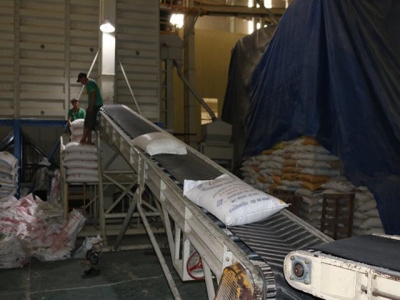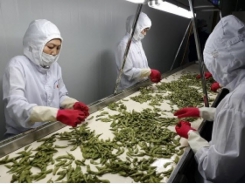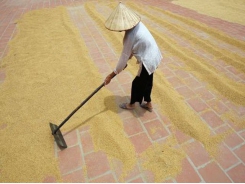Viet Nam loses out on global market without rice brand

Vietnamese rice exporters often ship in 50-kilogramme bags under the labels of their foreign distributors. — VNS Photo Hoàng Nguyên
LONG AN — Trung An Hi-tech Farming JSC in the Cửu Long (Mekong) Delta has been exporting rice under foreign brand names for many years though it is itself one of the biggest rice exporters in Việt Nam.
Speaking to the media on the sidelines of the third Vietnamese Rice Festival in Long An Province last December, Phạm Thái Bình, the company’s director, said to let consumers know about Vietnamese rice products, exporters like his company have to be able to show consumers their brand logos.
“But at the moment we still depend on buyers, which means they decide the packaging and labelling and we only have to follow instructions.
“Some markets allow the phrase ‘origin in Việt Nam’ to be written on the package, and that is already quite generous.”
He said foreign buyers usually order in bulk and want 50kg packaged under their name.
“They do not have to introduce Vietnamese rice to consumers, they just want to promote their own brands.”
According to the Ministry of Agricultural and Rural Development (MARD), Việt Nam exports to 150 markets yet global recognition of Vietnamese rice brands is still very low
Last December, it unveiled the official Việt Nam rice brand logo hoping to create a firm foothold in the global market.
Bình said it was an important move because it would help consumers identify Vietnamese rice since the logo is on the package.
But having a national brand does not mean it would automatically enhance the value of Vietnamese rice, he said.
“Whether or not we can increase the value depends on the quality of the product. Quality decides everything. Even the national rice brand can only be successful if companies and farmers collaborate to improve product quality.”
Nguyễn Quốc Toản, acting director of MARD’s Deparment of Agricultural Market Processing and Development, had emphasised the importance of quality at the launch of the national brand logo.
“The main issue [when building a brand for Vietnamese rice] is product quality because no brand will be accepted when the quality is poor.
“First and foremost, we need to improve the quality of our rice grain to not only meet the requirements of traditional rice markets but also niche markets in future.”
He said enterprises and farmers must work together very closely to enhance the value of Vietnamese rice.
Reduce quantity to improve quality
Dr Nguyễn Đức Thành, director of the Institute of Economic and Policy Research, told Việt Nam News that consumers are now more demanding than ever.
“They want to buy clean and organic rice whose production is traceable.”
He said farmers have to meet those requirements but cannot do it by themselves.
Việt Nam introduced a national rice brand logo last December as part of efforts to get a foothold in the global market
They have to work with enterprises because the latter work directly with consumers and have the responsibility to ensure people can buy good quality products, he said.
“Only by joining hands can farmers and enterprises tap foreign markets.”
He also pointed out that due to low productivity, farmers have to grow three rice crops a year instead of two as recommended by scientists for sustainability, which leads to low quality and almost no value addition.
If the non-agricultural sector grows further, farmers could abandon the third crop, he said.
“Production may decrease but quality will improve and bring more value.”
According to Dr Nguyễn Văn Sánh, former director of the Mekong Delta Development Research Institute, the delta, the country’s rice basket, has been hit by climate change in recent years, which has brought challenges such as changing water flows, low market competitiveness and overexploitation of agricultural resources.
Besides, production costs increase while quality deteriorates, he said.
“To develop a sustainable rice industry, farmers, enterprises and administrators must be ‘smart’ in production and trading.”
It can be done by selecting appropriate rice varieties, making use of ecological advantages through regional and sub-regional integration, improving production techniques, and adopting effective mechanisms and policies, he added.
Domestic market
Dr Thành noted that enterprises need to pay more attention to communication and advertising to build their brands in the domestic market first before expanding overseas.
He said though advertising is costly, without communication consumers cannot know and would continue to think that foreign rice is better than Vietnamese rice though it is not always the reality.
He said high-income families prefer to buy imported rice from Japan, Thailand or South Korea, and so building rice brands should not only be for international markets but also the domestic market.
“We can sell Vietnamese rice at supermarkets overseas but on a small scale. At the moment the biggest market for us is the domestic market.
“It has 100 million people who eat rice every day.
“Only a small number of highly selective consumers care about rice brands while the majority are indifferent.
“The domestic market is very sustainable for us as it is familiar and we have knowledge about the local market and consumers.”
Related news
Tools

Phối trộn thức ăn chăn nuôi

Pha dung dịch thủy canh

Định mức cho tôm ăn

Phối trộn phân bón NPK

Xác định tỷ lệ tôm sống

Chuyển đổi đơn vị phân bón

Xác định công suất sục khí

Chuyển đổi đơn vị tôm

Tính diện tích nhà kính

Tính thể tích ao



 Rice export growth may slow as demand drops…
Rice export growth may slow as demand drops…  High-tech application in planting black pepper
High-tech application in planting black pepper